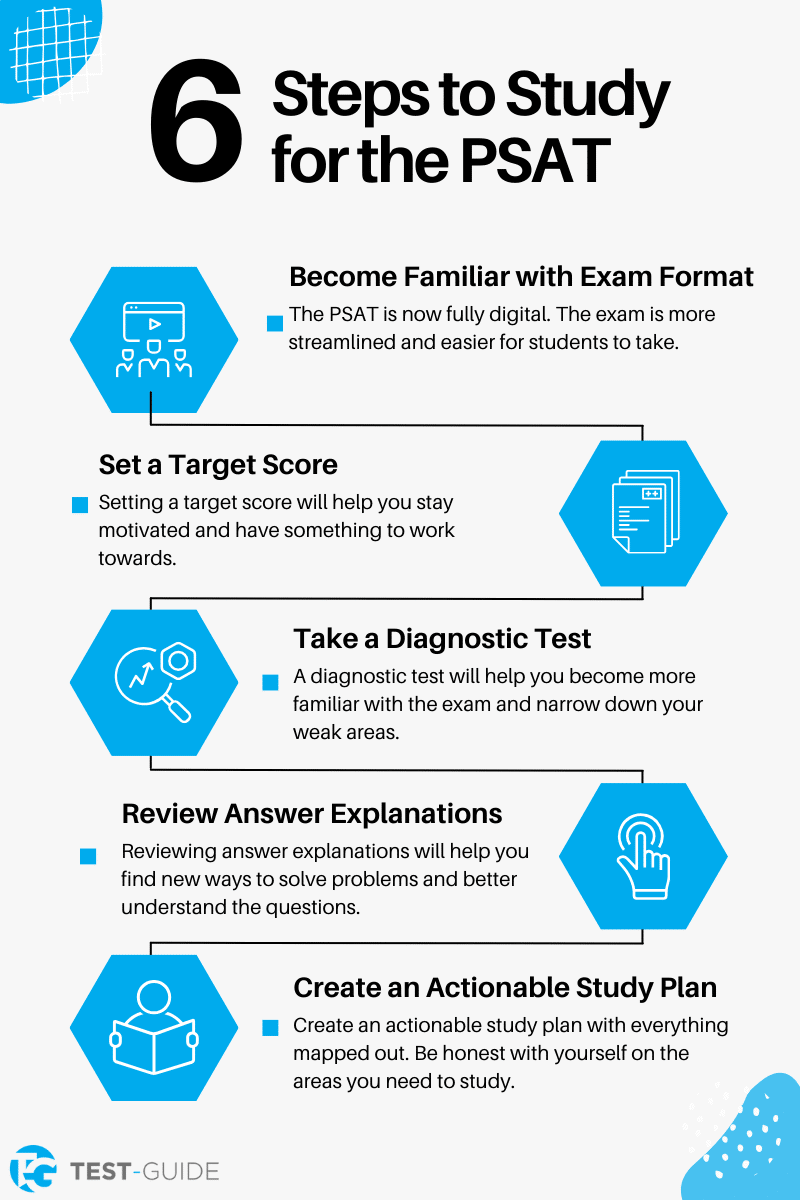Preparing for the PSAT? We have listed the exact steps you can follow to learn how to study for the PSAT.
In addition, we have also listed some tips and tricks to help you prepare. If you want to start practicing, take our PSAT practice test.
How to Study for the PSAT: Steps to Follow
Follow these steps to ensure you are prepared for the PSAT.
Step 1: Become Familiar with the Exam Format
The PSAT recently underwent some changes and is now fully digital. The exam is more streamlined and quicker for students to take. With that being said, it is important to understand the exam before you take it.
| Section | Number of Questions | Length (Minutes) |
|---|---|---|
| Reading and Writing Module 1 | 27 | 32 |
| Reading and Writing Module 2 | 27 | 32 |
| Math Module 1 | 22 | 35 |
| Math Module 2 | 22 | 35 |
| Total | 98 | 134 |
The exam is mostly multiple-choice. There are some questions within the math modules that require you to write in your own answers (student produced responses). You can learn more about this exam with our in-depth guide on what is the PSAT.
Step 2: Set a Target Score
It is always important to set goals, whether that be in life or before taking a test. Setting a target score will help you have something to work towards and give you some extra motivation to achieve that score.
When setting a target score, you need to ask yourself what your goals are. If your main goal is to qualify for a National Merit Scholarship, you will need to set a high target score (top 1% of test-takers).
If your main goal is to use the PSAT to prepare for the SAT, then you can set a target score that aligns with what you would want to score on the SAT.
For more information on scores, read our guide to PSAT scores.
Step 3: Take a Diagnostic Test
Taking a diagnostic test is important because it will allow you to do the following:
- Become more familiar with the exam.
- Figure out which areas of the exam give you the most trouble.
- Get a general idea of where you stand.
Taking a diagnostic exam will help you narrow down which areas you need to study / work on the most. This can help you study more efficiently and save some valuable time.
If you are looking to take a diagnostic exam, take our free PSAT test.
Step 4: Review Answer Explanations
After taking your diagnostic exam, make sure you review the answer explanations. These explanations will help you understand why an answer was correct or incorrect.
In addition, the explanations may help you discover a new way to solve a problem. Since the PSAT is timed, you must be efficient when taking the exam. Learning new and more efficient ways to solve problems will be very beneficial for you when it comes to taking the exam.
Step 5: Create an Actionable Study Plan
After taking your first diagnostic exam and reviewing the explanations, create an actionable study plan. To do this, consider the following:
- Which modules gave you the most trouble?
- Which questions gave you the most trouble?
- Was timing an issue?
It is important to be honest with yourself when asking these questions. Being honest with yourself will help you put together an actionable plan that you can follow.
When it comes to putting together an actionable plan, we recommend mapping everything out. An example of this could be:
- Week 1, Day 1: Study Reading & Writing Strategies
- Week 1, Day 2: Study Reading & Writing Questions (Individual Questions)
- Week 1, Day 3: Take Only the Reading & Writing Portion of the PSAT
Everyone will have different needs, but making your study plan actionable and specific will help you stick to it and follow it.
Step 6: Take Additional Practice Exams
After creating and following your study plan, take additional practice exams to track your progress. If you take another full-length PSAT exam and score your target score, then you should be all set for test day!
If you take another practice exam and do not score your target score, no worries. You can revisit step 5 and continue to study.
Tips to Prepare for the PSAT
The PSAT is an important exam for individuals who want to qualify for a National Merit Scholarship. If you want to ensure you qualify, here are some additional tips to help you succeed:
- Review Key Math Concepts: Make sure you are comfortable with key math concepts. Most concepts will be topics you were taught in high school.
- Review Key Reading and Writing Concepts: These will be things like reading comprehension, grammar, and writing. Most of these concepts can be reviewed with a practice exam.
- Take Practice Tests: We have really stressed this, but it is important. A practice exam will help you tremendously.
- Be Honest With Yourself: This applies when you are reviewing your old exams or building a study schedule. Figure out which areas give you the most trouble and really focus on those areas.
- Have a Focus on Time Management: Timing is an issue on the PSAT for many students. Make sure you are comfortable with the timing aspect of the exam. Find a pace that works well for you.
- Manage Your Stress: Remember, the main purpose of the PSAT is to prepare you for the SAT. Colleges do not look at your PSAT scores or use them during the college admissions process. The PSAT is used for the National Merit Scholarship, but there are plenty of other scholarship opportunities if you do not qualify for the National Merit Scholarship.


